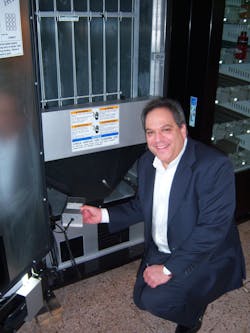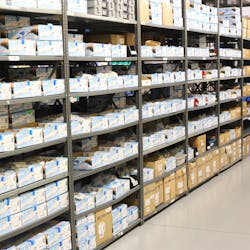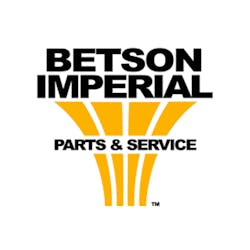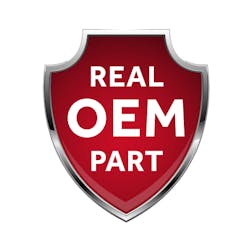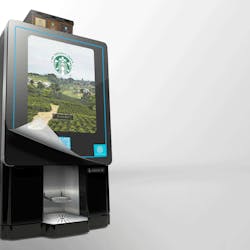Going “green” has become one of the strongest customer-driven demands for businesses in recent years. For vending operators, there are several aspects to providing a more environmentally friendly service, a key one being the use of energy efficient machines.
Adapting more energy efficient machines is not a simple proposition. Machines need to be retrofitted or replaced. In a challenging business climate such as the present, operators need good reason to invest in new machines and upgrades.
Vending operators are nonetheless finding that it pays to use machines that consume less electricity. By offering such machines, operators meet the needs of many customers who want their facilities to consume less energy. Government accounts in particular have required more energy efficient machines in recent years.
Because many accounts expect operators to compensate them for the electricity their machines use, energy efficient machines give operators a way to lower this cost.
Since 2004, many operators have been able to provide energy efficient cold beverage machines by offering Energy Star certified machines. The Energy Star program has become fairly well known to consumers since it applies to a variety of appliances. The Energy Star sticker indicates an appliance meets energy efficiency guidelines set by the Environmental Protection Agency (EPA) and the Department of Energy (DOE).
Energy Star certified cold drink machines incorporate more efficient compressors fan motors, lighting and better insulated compartments to keep beverages cold and the machine visible while using less energy.
Prof. Michael Kasavana, the National Automatic Merchandising Association endowed professor, wrote an extensive article on the Energy Star program in the March 2009 Automatic Merchandiser that can be accessed at www.vendingmarketwatch.com.
Energy Star standards evolve
While Energy Star gives the vending industry new tools to meet customer needs, evolving rules can create confusion for operators and customers alike.
The Energy Star program for cold drink machines began in 2004. A second set of standards known as “tier 2,” which further reduced energy consumption, took effect in 2007.
In August of 2012, newly-built cold drink machines will have to meet even more stringent DEO standards. The DOE rules will no longer be voluntary, and third party verification of compliance will also be required.
Further complicating the issue is that the 2012 DOE rules for OEMs are not part of Energy Star. Meanwhile, a third tier Energy Star specification will be announced in 2012 or 2013 for remanufactured vending machines.
“They (DOE) will continue to raise the bar,” said Tom Edwards, vice president of global food and beverage innovation at Crane Merchandising Systems. He noted that all newly-built CMS machines meet and exceed government energy efficiency standards.
Operators have choices
Fortunately, vending operators are not required to have new machines. But many find they are receiving more inquiries from customers who want to know they are operating energy efficient machines. Operators who offer the most efficient machines will have a competitive advantage in some situations.
Besides offering machines that meet current government standards, operators also have the option of using aftermarket products that manage energy use. “There are a lot of vending operators that don’t want to buy new equipment,” said Doug Parsons, president of Area Wide Inc., an equipment distributor in Waynesville, Ohio.
Aftermarket devices that regulate energy use have been used for more than a decade. While these products remain an option for operators looking to conserve energy, not all aftermarket products qualify a machine for Energy Star.
The DOE offers a list of remanufactured machines that meet Energy Star requirements on its Website at http://www.energystar.gov/ia/products/prod_lists/vending_machines_prod_list_rebuilt.pdf
The most widely used aftermarket device is the VendingMiser, a passive infrared sensor that determines the vending environment is vacant, then powers down the machine to conserve energy when no one is in the area. The product is currently sold by Malvern, Pa.-based USA Technologies Inc.
Many government accounts have mandated VendingMisers and utility companies have provided rebates to customers and vending operators for installing them. In 2003, more than 20 utility companies offered rebates nationwide.
Operators see concern rising
A random interview of operators indicated that customer interest in energy efficiency is rising. The level of customer concern varies, as does the interest among operators to upgrade their machines to the highest efficiency.
“We have a lot of locations that have asked us to delamp the equipment,” said Jerry Scott, general manager of Canteen of Coastal California Inc. in Oxnard, Calif. In response to these requests, Scott’s company makes it a point to buy new machines that have LED lights instead of fluorescent lights, which consume more electricity.
Scott has also found it worth his trouble to offer Energy Star certified machines when seeking new accounts. Government accounts have been requiring Energy Star machines for some time, he said, but private businesses are beginning to ask for it as well.
Scott said he has found it a competitive advantage to offer Energy Star machines.
California is one of several states where vending operators can receive rebates for using energy efficient equipment, Scott said.
He has been earning rebates through a statewide program for VendingMisers.
Mike Bunt, general manager of corporate marketing equipment at Buffalo Rock Co., the Birmingham, Ala.-based Pepsi bottler and vending operator, said he has been getting requests for Energy Star machines from big national accounts. “It’s here; it’s going to get bigger and bigger,” he said.
Bunt, whose company has more than 100,000 cold drink machines, prefers to buy Energy Star certified machines rather than using aftermarket products. “There’s more to it than just putting the kit on it and saying it’s Energy Star,” he said.
D & S Food Service Inc., in Menomonee Falls, Wis., has been taking advantage of a state rebate program for years, noted Dave Kwarciany, Jr., company vice president. In Wisconsin, Energy Star vending machines can get $100 rebate and $60 for an energy control device from an organization called Focus On Energy. “My preference is to only invest in new equipment,” said Kwarciany, whose company owns 95 percent of the cold beverage machines it operates.
Dave Bloomquist, vice president of D&R Canteen in Rochester, Minn., said he has not been getting requests for Energy Star machines per se. He does, however, get requests to do something about rising energy costs. In these cases, Bloomquist looks to see if a machine can be removed from the account. In today’s highly competitive environments, some accounts are over equipped.
New machines versus aftermarket products
Next Generation Vending & Food Service Inc., a company with an aggressive “green” initiative based in Canton, Mass., prefers to use new equipment to aftermarket products, noted Darryl Perkins, senior program manager for information systems. Aftermarket products that shut down the machine created a problem for the company’s remote machine monitoring.
The shutdowns were not a problem as long as the power returned within 12 hours, Perkins said, but beyond 12 hours, the machine did not send the regularly scheduled data.
Shut downs caused by these devices have created other problems as well.
“We had a problem with people not using the machine because they assumed it was broken,” said Tim Fitzgerald, IT manager at CC Vending, Bronx, N.Y. CC Instead of devices that shut down the power, CC Vending is using Energy Star machines and promoting them to new clients.
For all the benefits some operators see in using new equipment, aftermarket products still have their appeal. And in recent years, aftermarket products have evolved.
Aftermarket products evolve
Mike Ehrentreu, owner of Aldar Vending Inc., a 19-route operation in Hackensack, N.J., has found success with a device from a company based in Fairfield, N.J., Energy Innovative Products Inc. (EIP), that makes a kit that controls the amount of energy the compressor uses based on the environment. Ehrentreu likes the fact that EIP does not shut down the machine.
“It’s keeping the beverages cold and saving energy at the same time,” Ehrentreu said. “It doesn’t waste amps from the compressor.”
American Vending & Coffee Service in Randolph, N.J. has also been satisfied with EIP, noted Drew Warner, president. Warner initially used a device that shut down the machine, but became dissatisfied when there were complaints from customers. “They (customers) wanted to know where the savings was,” he said.
The cost savings he gets with EIP have allowed him to reduce the costs he was compensating customers for.
“It’s really allowed us to save, to educate our customers about ways to save money and reduce their energy costs,” Warner said. “It’s allowed us to stay ahead of our competition.”
EIP has a series of products, including a kit that makes a machine Tier 2 Energy Star certified. The products have a compressor motor controller which is installed in between the vending machine's thermostat and the refrigeration compressor.
Scott Caputo, president of EIP, said the controller gives the ability to control the amount of energy the machine’s compressor consumes based on the environment. The system determines the amount of energy needed without affecting the temperature of the product.
The wattage drops from 172 watts to 40 watts based on need, without affecting the motion in the motor.
Caputo said EIP will allow machines to meet the stricter 2012 standards. The company will be exhibiting at the NAMA OneShow with Vendors Exchange International Inc., which distributes EIP products nationwide.
Elstat Americas, based in Marietta, Ga., has demonstrated its technology to vending operators in the last year. The Elstat device learns the patterns of the environment in which the machine operates via an infrared motion detector. By learning about its environment it ensures that optimum operating temperatures are maintained exactly when required.
Chris Mumford, the West Bloomfield, Mich. vending consultant, said the Elstat device typically saves a third of the energy cost. He noted that the device does not make a machine Energy Star compliant.
Chuck Ropke, vice president of corporate services for Columbus, Ohio-based Shaffer Distributing, which distributes Elstat nationwide, said the device meets many state requirements for energy savings. In Ohio, for example, the product meets the requirements of blind services contracts.
Elstat will be introducing a new product at this year’s NAMA OneShow.
Vending operators have more options to offer energy efficient machines. In confronting a customer base that has become more energy conscious, operators will find it pays to be up to speed on government energy regulations and the many products that address this rising customer concern.
